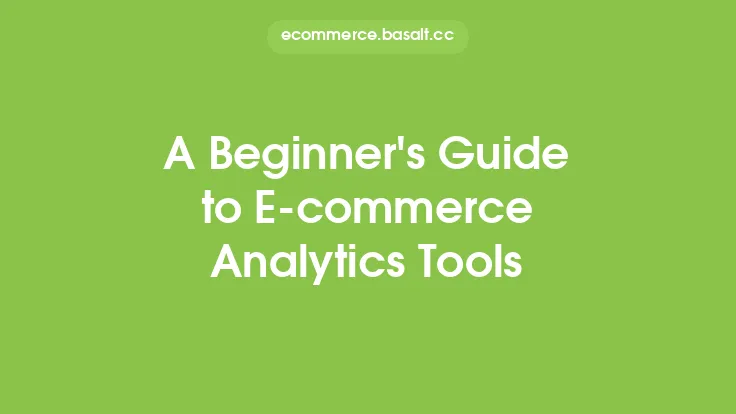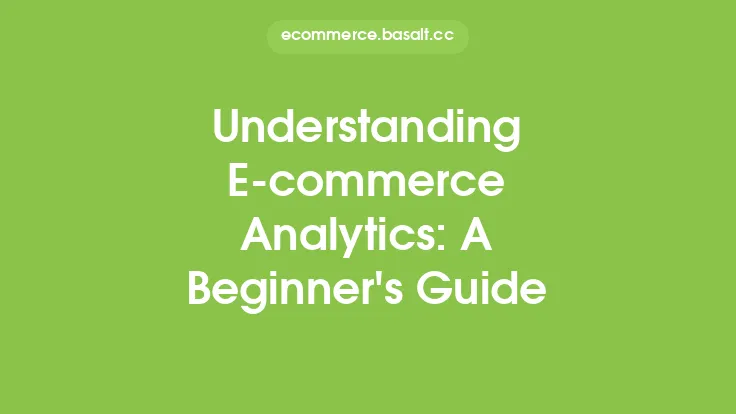Getting started with e-commerce reporting can be a daunting task, especially for those new to the world of online retail. With so many metrics and data points to track, it's easy to feel overwhelmed and unsure of where to begin. However, having a solid understanding of e-commerce reporting is crucial for making informed decisions and driving business growth. In this article, we'll cover the basics of e-commerce reporting, including what it is, why it's important, and how to get started.
What is E-commerce Reporting?
E-commerce reporting refers to the process of collecting, analyzing, and presenting data related to an online store's performance. This data can include metrics such as sales, website traffic, customer behavior, and product performance, among others. The goal of e-commerce reporting is to provide insights that can help online retailers optimize their business, improve customer experience, and increase revenue.
Why is E-commerce Reporting Important?
E-commerce reporting is essential for online retailers because it provides a clear picture of how their business is performing. By analyzing data and metrics, retailers can identify areas of strength and weakness, make informed decisions, and develop strategies to drive growth. Some of the key benefits of e-commerce reporting include:
- Improved decision making: With accurate and timely data, retailers can make informed decisions about product offerings, marketing campaigns, and operational improvements.
- Enhanced customer experience: By analyzing customer behavior and preferences, retailers can create personalized experiences that drive engagement and loyalty.
- Increased revenue: By identifying areas of opportunity and optimizing business performance, retailers can increase revenue and drive growth.
- Competitive advantage: In a crowded and competitive e-commerce landscape, retailers who leverage data and analytics to inform their decisions can gain a significant advantage over their competitors.
Key Components of E-commerce Reporting
There are several key components of e-commerce reporting that retailers should be aware of. These include:
- Sales reporting: This includes metrics such as total sales, average order value, and conversion rates.
- Website traffic reporting: This includes metrics such as page views, unique visitors, and bounce rates.
- Customer behavior reporting: This includes metrics such as customer demographics, purchase history, and browsing behavior.
- Product performance reporting: This includes metrics such as product sales, revenue, and profit margins.
- Marketing reporting: This includes metrics such as campaign performance, return on ad spend, and social media engagement.
How to Get Started with E-commerce Reporting
Getting started with e-commerce reporting can seem overwhelming, but there are several steps retailers can take to begin. These include:
- Identifying key metrics: Determine which metrics are most important to your business and focus on tracking those.
- Setting up analytics tools: Utilize analytics tools such as Google Analytics to collect and analyze data.
- Creating reports: Use data to create reports that provide insights into business performance.
- Analyzing data: Regularly review and analyze data to identify trends, opportunities, and areas for improvement.
- Taking action: Use insights from data to inform decisions and drive business growth.
Best Practices for E-commerce Reporting
There are several best practices that retailers should follow when it comes to e-commerce reporting. These include:
- Regularly reviewing and updating reports: Ensure that reports are accurate and up-to-date to inform decision making.
- Using data visualization: Use charts, graphs, and other visualizations to make data easier to understand and interpret.
- Segmenting data: Segment data to gain insights into specific customer groups, product categories, or marketing channels.
- Using automation: Automate reporting processes wherever possible to save time and reduce errors.
- Staying flexible: Be prepared to adjust reporting strategies as business needs and goals evolve.
Common Challenges in E-commerce Reporting
There are several common challenges that retailers may face when it comes to e-commerce reporting. These include:
- Data quality issues: Poor data quality can lead to inaccurate insights and decision making.
- Limited resources: Small or medium-sized retailers may not have the resources or expertise to effectively collect and analyze data.
- Information overload: With so many metrics and data points to track, it can be difficult to know where to focus.
- Lack of standardization: Different analytics tools and platforms may use different metrics and terminology, making it difficult to compare data.
Overcoming Challenges in E-commerce Reporting
To overcome challenges in e-commerce reporting, retailers can take several steps. These include:
- Investing in analytics tools: Utilize analytics tools that can help collect, analyze, and visualize data.
- Developing a data-driven culture: Encourage a culture of data-driven decision making within the organization.
- Seeking expertise: Partner with experts or consultants who can provide guidance and support.
- Focusing on key metrics: Prioritize key metrics and focus on tracking those to avoid information overload.
- Standardizing processes: Establish standardized processes and terminology to ensure consistency across the organization.
Conclusion
E-commerce reporting is a critical component of online retail success. By understanding the basics of e-commerce reporting, retailers can make informed decisions, drive business growth, and stay ahead of the competition. While there are challenges to overcome, retailers can take steps to ensure accurate and effective reporting, such as investing in analytics tools, developing a data-driven culture, and seeking expertise. By following best practices and staying focused on key metrics, retailers can unlock the full potential of e-commerce reporting and drive long-term success.




